Burke Hopes to Cure Disease, "Hook" Students, Via Molecule-Making Machine
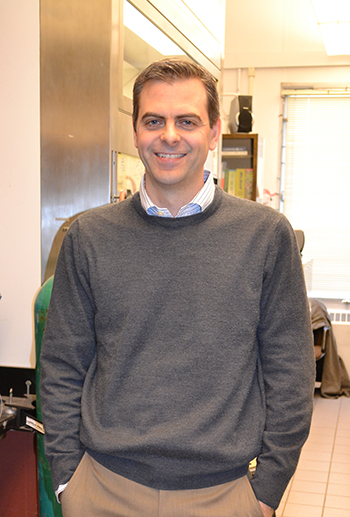
Illinois Chemistry Professor Martin Burke
May 21, 2015
Marty Burke’s life-long dream was to become a doctor. Then one day, while chatting with a 22-year-old patient with cystic fibrosis whom he was helping to care for, he had an epiphany:
“We had this big conversation about her disease,” recalls Burke, “and I was telling her— because I had just learned about it—down to the molecular level, exactly what was wrong with her. And she said to me, ‘If you know exactly what’s wrong with me, why can’t you fix it?’ It was one of those totally life-changing conversations.”
And it did totally change his life. Based on that interaction, Burke altered the course of his career to become a researcher and is now working to develop a cure for cystic fibrosis and other diseases caused by a deficiency of protein function. Now, instead of the limited number of patients a physician might directly impact in his lifetime, he hopes to have a world-wide impact through his research: the synthesis and study of small molecules with protein-like functions.
“The power of science is that if you discover one thing, it could have the leverage that now millions of people around the world could benefit,” admits Burke.
So Burke and the members of his research group at Illinois, Burke Laboratories, are working to create molecules that replicate the function of proteins. Burke says both too much or too little protein can cause disease.
For example, he says a lot of diseases are caused by too much protein. Doctors currently have good treatments for those: lots of medicines, like aspirin, are inhibitors: they bind to proteins and turn them off. Unfortunately, many diseases are caused by deficiency of protein function. “In most of those cases,” admits Burke, “there’s very little we can do.” This is the case with cystic fibrosis.
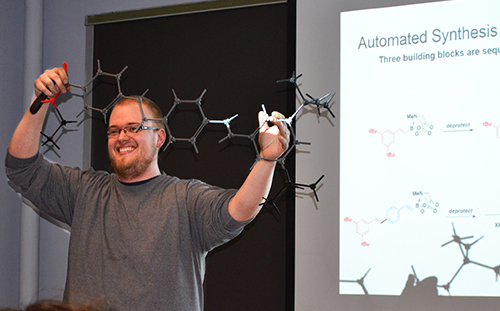
Ph.D. student Michael Schmidt , a member of Burke's research group, shows Uni High students a model of a molecule.
According to Burke, individuals with the disease are missing a protein in their lungs, an ion channel that allow anions (negatively charged ions) to pass through the membranes. Because they can’t clear infections from their lungs, patients have chronic infections. Burke says doctors can give them medicine (some patients take up to 20 types of medicine a day), such as antibiotics, to try to break up the mucus, or bang on their chests to clean the mucus out. But the only recourse doctors have is to treat the symptoms, not address the defect itself.
“There are diseases where even if you’re the most well-intentioned doctor and you passionately care about your patients, there’s just only so much you can do. There’s a lack of tools to help them, and so I wanted to focus on that.”
So Burke hopes to provide doctors with the tools they need to actually heal the patients. He is working to address the defect itself: to synthesize a molecule that can serve as the missing protein.
“Can we make molecules that serve as prostheses on the molecular scale—a molecular mimic of missing protein?” Burke asks. He’s dedicated his life’s work to answering that question.
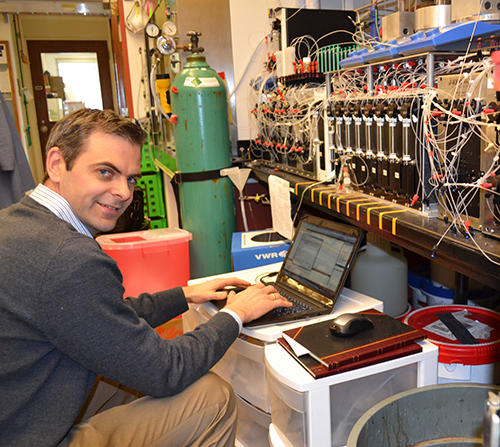
Marty Burke and his molecule-making machine.
Burke has even coined a phrase to describe the nanotechnology, or nanomedicine, he hopes to develop to address this defect: “Molecular prosthetics: small molecules that replace missing proteins as a way to try to treat those diseases. That’s been our mission from the day we started.”
However, Burke admits that he and his cohorts soon ran into a glitch: “What we found really quickly, the slow step—the bottleneck in our research program—was our ability to make these molecules in the lab.”
According to Burke, that has traditionally been “really, really slow.”
“So that bothered us,” he continues. “A lot. So we wanted to figure out how to make molecules better so we could get access to all this function.”
That’s when Burke and company decided to speed things up: “The bottom line is, we built a machine!”
Burke goes on to explain the potential of his ground-breaking invention (which Burke and company affectionately call, "The Machine"): “We’re pretty excited about this, because we think this helps us accelerate our studies, and we want to get at this function, the potential that we think exists, and we think that this machine is going to help us get there. The beauty of this is, you load cartridges, and you press start!”
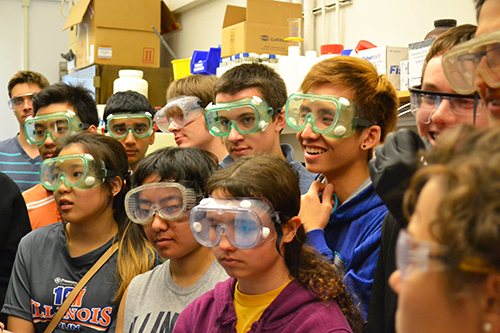
David Bergandine's class of students from Uni High appreciate seeing the molecule-making machine up close.
“So we’re literally trying to make molecules that could replace the cystic fibrosis channel, for example.” It turns out that that’s one of literally hundreds of diseases that are now known to be caused by missing a single protein. And now that they can make molecules quickly, they intend to address a number of those:
“We think it’s a generalizable concept,” says Burke. “We’re working on asthma, anemia (missing hemoglobin), a disease caused by missing protein in the red blood cells (hemoglobinopathy). We’re working on trying to make an artificial blood—make a molecule that could replace your blood. This is something that we’re very excited about. We’re working on this as we speak.”
So Burke and his research group are well on their way, and his machine could not only help his group, but other scientists around the world, find cures for a raft of diseases. In fact, he and his mentees are so confident about their machine that they recently had David Bergandine's chemistry class from Uni High visit the lab to learn about, then actually synthesize, some molecules. And after learning about the process, the high schoolers did just that!
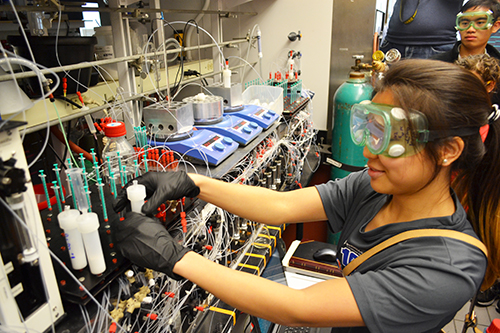
A student from David Bergandine's class adds "an ingredient" to the deprotection module of the molecule-making machine.
Burke and his team were delighted to expose the students to their research in hopes that a couple of them might be inspired to join them down the road. “I am such a fan of talent…I can’t even tell you. To have a group of exceptionally talented students and a chance to hook one of them, maybe. We would love it if that happened.”
Burke’s lab also has an outreach program: Lab Partners. So far, Catlin High School (a rural school about an hour east of Champaign-Urbana) has participated. Why Catlin? Burke, who grew up in Manchester, Maryland (an hour north of Baltimore), has a soft spot in his heart for kids from the boonies.
“I grew up in a very small town,” he confesses. “We literally had more cows than people. One traffic light.”
So how did Burke go from cows to becoming a ground-breaking researcher? He was inspired by a couple of the few STEM role models available to him growing up. One, his family doctor, inspired him to be a doctor and eventually go to medical school. And his elementary school vice-principal, on recognizing how excited Burke was about becoming a doctor, even arranged for him to watch an open-heart surgery—up close. Burke actually scrubbed in with the surgeons, then watched as the surgeon explained everything he did.
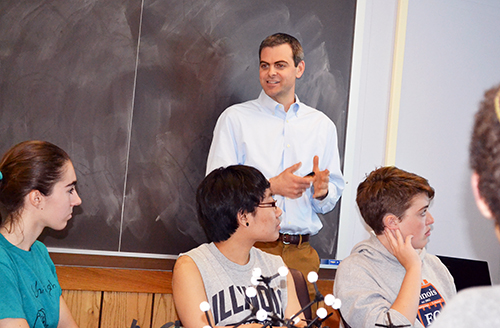
Burke explains his research to Uni High students during their visit to his lab.
How’d he do? Did he pass out? Nope.
“I was so fascinated,” Burke says. “It was totally life changing. I remember that day to this day. Then I met the guy the next day; he was talking about his grandkids. At that point, I was like, ‘That’s what I want to do with my life.’”
And of the two chosen career choices he had as a youngster, being a doctor was the one that panned out: “You grow up in the U.S., and you’re an ambitious young person, and you end up wanting to become a baseball player or a doctor. Those were my two goals. The Orioles never called, but Hopkins did.”
So he went to John Hopkins for undergrad, “totally thinking I wanted to become a medical doctor,” he reports. He went on to do an MD and PhD at Harvard, “very much thinking I wanted to become a doctor.” That was his plan, right up until his watershed moment with the cystic fibrosis patient, when he “discovered science—particularly chemistry—and the power associated with this.” So he switched careers, and in 2005, came to Illinois to research protein synthesis and started Burke Laboratory.

Above & below: Molecules the Uni HIgh students synthesized on "The Machine" (images courtesy of Burke Laboratories).
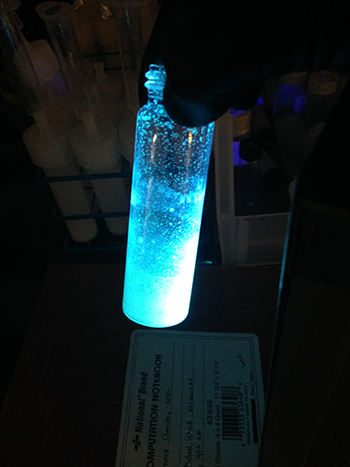
He still respects doctors and what they do: “I think being a physician is awesome. Make no mistake about that. I love the whole profession, and I think it’s incredibly wonderful way to directly impact on patients.” But he wanted to help more people: “I think I became addicted to the idea that you could have potentially major leverage in the lab, because something discovered might help millions of people.”
Besides helping people world-wide, there are also a few he wants to help locally. Having grown up in a rural area, Burke recognizes that kids from rural areas often haven’t had the kinds of exposure to STEM that urban kids have. “I realized, only in retrospect, I had never met a scientist before I went to college.” So for these rural kids, he hopes to change this, and targets this population in much of his STEM ed outreach.
In hindsight, it was another STEM role model, his high school chemistry teacher, who most likely had a greater impact than even his doctor. Through a relationship the teacher had with a company, the class had the opportunity to synthesize aspirin in a lab. “I didn’t know it at the time,” says Burke, “but that’s pretty special; that’s not normal in a high school, certainly not in rural America.” He shares an anecdote about how this experience paid off big time.
“When I went to college, I was getting my butt kicked at Hopkins when I first got there. All of these kids had come from more well-prepared backgrounds, and I was coming from more cows than people. But I had taken this synthesis part with him [his high school chemistry teacher], and had gotten a head start, if you will, in organic chemistry…I think that really helped me a lot.”
So Burke and company hope to give high school kids a head start—especially those from rural schools, which he believes have as many bright youngsters as do urban schools.
“I firmly believe talent is broadly distributed. The idea is you want to level the playing field so as many young people as possible can be exposed to different fields, so that the most brilliant, talented people can get hooked on the right stuff and maybe decide to do it.”
So he started the Lab Partners program, where they bring a class of high school students to campus. Their goal is to recruit kids into chemistry or, at the very least, convince kids who don’t intend to go to college to consider doing so:
“The hope is that even if they don’t all become chemists, we can just hopefully lower their apprehension and lack of familiarity with the college experience, so they can see this is something that might be in their future…just lowering the threshold to thinking about college, and coming here to the university, and pulling the curtain back.” After he and his grad students have lunch with the students, his students share “how much fun they had in college and how great it is to pursue these things.”
And, of course, they get the high school students into the lab, where—you guessed it—they make aspirin. Burke figures, if it worked once, why not try it again?
Of course, their ultimate goal is to recruit some into their particular niche: molecule systhesis:
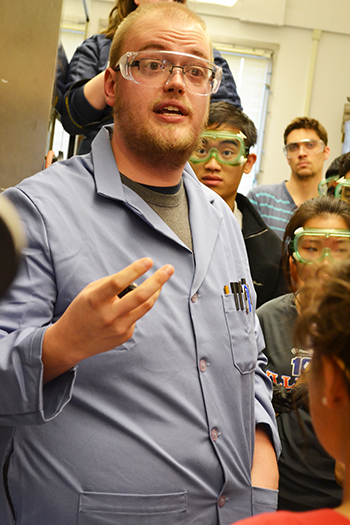
Michael Schmidt, one of the grad students in Burke's research group explains to Uni High students how "The Machine" synthesizes protein.
“We love the idea of trying to enable other students at the high school level to get a sense of this idea that you could make molecules. There’s something very powerful about that. They may not have existed anywhere in the universe. You’re making something that maybe it’s the first time it’s ever existed. It’s a pretty powerful concept.”
Burke hopes his machine is just the beginning in terms of molecule synthesis: “The long-term vision here would be to create an on-demand, small molecule synthesis platform. So anyone in the world, whether they be chemist, biologist, high school student, could just, on a computer, make a molecule. Press a button—it gets printed and sent to them.”
In fact, Burke envisions a scenario where some young person, armed with a molecule from his platform, makes a revolutionary discovery:
“Talent is well-distributed, and that includes geographic, race, sex, sexual orientation, but also age. And it’s going to be that 17-year-old kid in their garage or in their room, if we could hand them the power to make molecules, look out! Because it will be some brilliant high school student who thinks of a solution. We all think we know what we’re doing, but it’s going to be someone who’s got the right naivety, and just the right amount of knowledge to call it a different way of thinking. And if we could empower everybody to make molecules, look out! Because that outside-the-box thinking that comes from empowering non-experts to engage in a new area, that’s where history has a very strong track record of tremendous innovation.”
So part of Burke's agenda, in addition to sythesizing molecules and curing disease, is to to expose high school students to his research. “I think it hooked me, and hopefully we can get somebody else hooked on it,” he figures.
More: Faculty Feature, 2015
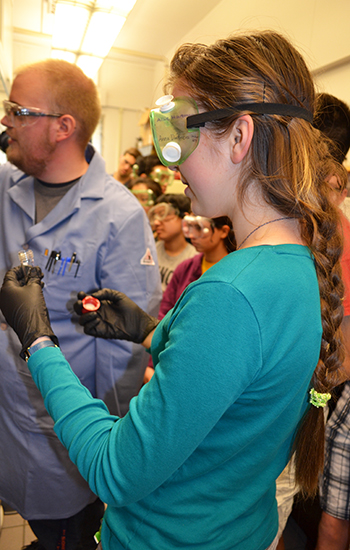
A Uni High student prepares to add an ingredient to the purification module of "The Machine."
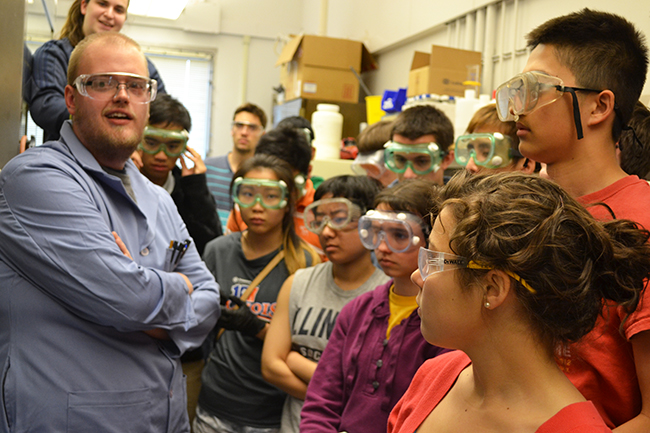
Ph.D. student Michael Schmidt (left), a member of Burke's research group, explains molecule systhesis to Uni High students.













.jpg)
















